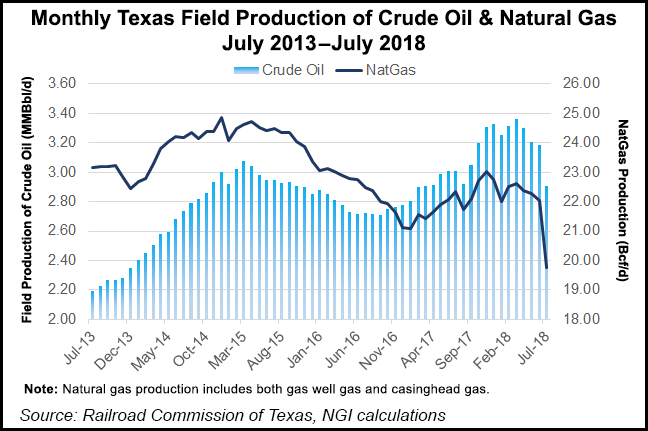E&P | NGI All News Access | NGI The Weekly Gas Market Report
Texas Oil Output in July Nears 3 Million B/d, Natural Gas Production Chases 20 Bcf/d
Texas crude oil in July averaged nearly 2.90 million b/d, compared with 2.43 million b/d a year ago, while natural gas output averaged 19.76 Bcf/d, versus a year-ago average of about 17.25 Bcf/d, according to a preliminary tally by the Railroad Commission of Texas.

The total volumes are based on production figures likely to be updated as late and corrected reports are received, the state’s oil and gas regulator noted.
In July, operators said they produced about 90.026 million bbl of crude oil and nearly 612.513 Bcf of natural gas, the preliminary figures indicated.
Reported oil production in July 2017 initially totaled 75.312 million bbl, which has since been updated to a current figure of 93.229 million bbl. Gas production preliminarily totaled for July 2017 was nearly 534.778 Bcf, since updated to a current figure of 692.430 Bcf.
Between August 2017 and July, total reported output was 8.1 Tcf of natural gas and 1.164 billion bbl of crude oil. Crude oil production reported to state officials is limited to oil produced from oil leases and does not include condensate, which is reported separately by the commission.
Texas production in July came from 180,434 oil wells and 91,025 gas wells, the commission said.
As of last Friday (Sept. 21), the oil and gas rig count in Texas had risen to 531 from 453 a year ago, according to Baker Hughes, a GE company.
The Permian Basin, the most active play in the United States, straddles West Texas and southeastern New Mexico.
Overall Permian oil production grew by more than 700,000 b/d in 2017 and continues to climb this year, according to a recent report by analysts at Raymond James & Associates Inc.
“Beyond that robust 2018 outlook, we see the growth rate accelerating again in 2019 (boosted by our above-consensus oil price forecast for 2018) with the 2019 exit rate standing at 4.6 million b/d (up another 800,000 b/d exit to exit for 2019),” analysts said of the Permian.
© 2024 Natural Gas Intelligence. All rights reserved.
ISSN © 2577-9877 | ISSN © 1532-1266 | ISSN © 2158-8023 |
